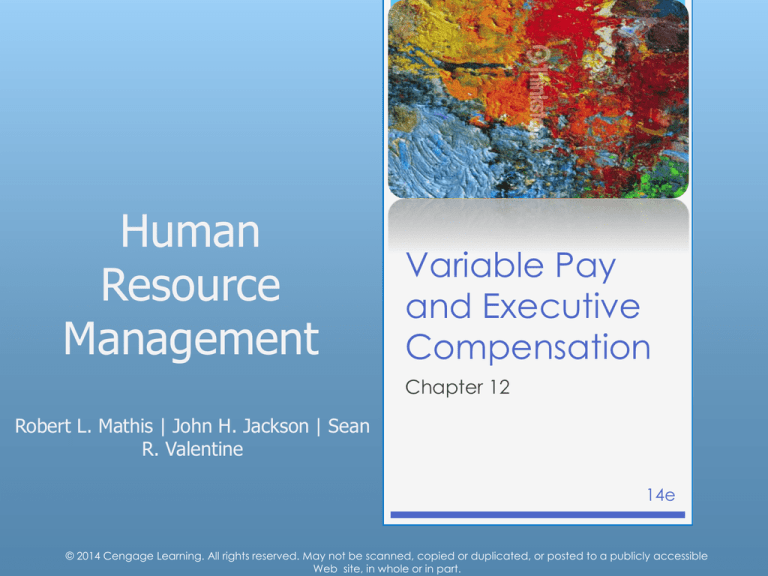
Human
Resource
Management
Variable Pay
and Executive
Compensation
Chapter 12
Robert L. Mathis | John H. Jackson | Sean
R. Valentine
14e
© 2014 Cengage Learning. All rights reserved. May not be scanned, copied or duplicated, or posted to a publicly accessible
Web site, in whole or in part.
Why Use Variable Pay?
Some people
perform better and
are more productive
than others
Better performing
employees should
receive more
compensation
Variable
Pay
Assumptions
Total compensation
should be tied
directly to
performance and
results
Some jobs
contribute more to
organizational
success than others
© 2014 Cengage Learning. All rights reserved. May not be scanned, copied or duplicated, or posted to a publicly accessible
Web site, in whole or in part.
Figure12.1 - A Variety of Possible
Incentives
© 2014 Cengage Learning. All rights reserved. May not be scanned, copied or duplicated, or posted to a publicly accessible
Web site, in whole or in part.
Developing Successful Pay-forPerformance Plans
Link strategic goals
and employee
performance
Enhance results and
reward employees
financially
Reasons for
Pay-for-Performance
Plans
Reward and
recognize employee
performance
Promote
achievement of
HR objectives
© 2014 Cengage Learning. All rights reserved. May not be scanned, copied or duplicated, or posted to a publicly accessible
Web site, in whole or in part.
Combating Variable Pay Complexity
Develop clear, understandable
plans that are continually
communicated
Use realistic performance
measures
Keep plans current and linked
to organizational objectives
Successful
Incentive
Plans
Link results to payouts that
recognize differences
Identify variable pay incentives
separately from base pay
© 2014 Cengage Learning. All rights reserved. May not be scanned, copied or duplicated, or posted to a publicly accessible
Web site, in whole or in part.
Figure12.2 - Factors for Successful
Variable Pay Plans
© 2014 Cengage Learning. All rights reserved. May not be scanned, copied or duplicated, or posted to a publicly accessible
Web site, in whole or in part.
Combating Variable Pay
Complexity
© 2014 Cengage Learning. All rights reserved. May not be scanned, copied or duplicated, or posted to a publicly accessible
Web site, in whole or in part.
Figure12.3 - Categories of Variable Pay
© 2014 Cengage Learning. All rights reserved. May not be scanned, copied or duplicated, or posted to a publicly accessible
Web site, in whole or in part.
Individual Incentives
© 2014 Cengage Learning. All rights reserved. May not be scanned, copied or duplicated, or posted to a publicly accessible
Web site, in whole or in part.
Figure12.4 - Purposes of Nonmonetary
Incentives
© 2014 Cengage Learning. All rights reserved. May not be scanned, copied or duplicated, or posted to a publicly accessible
Web site, in whole or in part.
Figure12.5 - Possible Reasons for Using
Group/Team Variable Pay
© 2014 Cengage Learning. All rights reserved. May not be scanned, copied or duplicated, or posted to a publicly accessible
Web site, in whole or in part.
Design of Group/Team Incentive Plans
© 2014 Cengage Learning. All rights reserved. May not be scanned, copied or duplicated, or posted to a publicly accessible
Web site, in whole or in part.
Group/Team Incentives
Challenges
with group/team incentives
Rewards distributed in equal amounts to all
members may be perceived as unfair
Free riders - Member of the group who contributes
little
Team size - Individual efforts of employees have
little effect on the total performance of the group in
large groups
© 2014 Cengage Learning. All rights reserved. May not be scanned, copied or duplicated, or posted to a publicly accessible
Web site, in whole or in part.
Figure12.6 - Conditions for Successful
Group/Team Incentives
© 2014 Cengage Learning. All rights reserved. May not be scanned, copied or duplicated, or posted to a publicly accessible
Web site, in whole or in part.
Types of Group/Team Incentives
Group/team
results
Group production
Cost savings
Quality improvement
Gainsharing:
Sharing with employees of
greater-than-expected gains in productivity
through increased discretionary efforts
Improshare
Scanlon plan
© 2014 Cengage Learning. All rights reserved. May not be scanned, copied or duplicated, or posted to a publicly accessible
Web site, in whole or in part.
Organizational Incentives
Profit Sharing
Primary Objectives
Drawbacks
• Increase productivity and
organizational performance
• Disclosure of financial
information
• Attract or retain employees
• Variability of profits from
year to year
• Improve product/service
quality
• Enhance employee morale
• Profit results not strongly
tied to employee efforts
© 2014 Cengage Learning. All rights reserved. May not be scanned, copied or duplicated, or posted to a publicly accessible
Web site, in whole or in part.
Figure12.7 - Framework Choices for a
Profit-Sharing Plan
© 2014 Cengage Learning. All rights reserved. May not be scanned, copied or duplicated, or posted to a publicly accessible
Web site, in whole or in part.
Employee Stock Plans
Stock
option plan
Employees can buy fixed number of shares of
company stock
At
a specified price for a limited period of time
Employee
stock ownership plan (ESOP)
Gives employees significant stock ownership in the
organization they work
© 2014 Cengage Learning. All rights reserved. May not be scanned, copied or duplicated, or posted to a publicly accessible
Web site, in whole or in part.
Figure12.8 - Metric Options for Variable
Pay Plans
© 2014 Cengage Learning. All rights reserved. May not be scanned, copied or duplicated, or posted to a publicly accessible
Web site, in whole or in part.
Types of Sales Compensation Plans
Salary-only
All compensation is paid as a base wage with no
incentives
Straight
commission
Compensation is computed as a percentage of
sales in units or dollars
Draw system makes advance payments against
future commissions to the salesperson
© 2014 Cengage Learning. All rights reserved. May not be scanned, copied or duplicated, or posted to a publicly accessible
Web site, in whole or in part.
Types of Sales Compensation Plans
Salary-plus-commission
or bonuses
Compensation is part salary for income stability and
part commission for incentive
© 2014 Cengage Learning. All rights reserved. May not be scanned, copied or duplicated, or posted to a publicly accessible
Web site, in whole or in part.
Types of Commission
Straight
commission system - Percentage
of the value of the sales is given to the
sales person
Advantage - Requires the sales representative to
sell in order to earn
Disadvantage - Offers no security for the sales staff
Draw: Amount advanced against, and repaid from,
future commissions earned
© 2014 Cengage Learning. All rights reserved. May not be scanned, copied or duplicated, or posted to a publicly accessible
Web site, in whole or in part.
Types of Commission
Salary-plus-commission
or bonuses
Compensation is part salary for income stability and
part commission for incentive
© 2014 Cengage Learning. All rights reserved. May not be scanned, copied or duplicated, or posted to a publicly accessible
Web site, in whole or in part.
Figure12.9 - Sales Metric Possibilities
© 2014 Cengage Learning. All rights reserved. May not be scanned, copied or duplicated, or posted to a publicly accessible
Web site, in whole or in part.
Executive Compensation
Handled
pay
differently than other employees’
Usually
more than business unit heads with
similar responsibilities
Is
a measure of the power that a CEO brings
to the organizational relationship
© 2014 Cengage Learning. All rights reserved. May not be scanned, copied or duplicated, or posted to a publicly accessible
Web site, in whole or in part.
Figure 12.10 - Difficult CEO
Responsibilities
© 2014 Cengage Learning. All rights reserved. May not be scanned, copied or duplicated, or posted to a publicly accessible
Web site, in whole or in part.
Changes in the Context of Executive
Compensation
Say
on Pay
Publically listed companies must allow share holders
to vote on executive compensation
Clawbacks
Allows a company to recover any incentive based
pay that was paid out during the prior 3 years if it
would not have been paid under restated financial
statements
© 2014 Cengage Learning. All rights reserved. May not be scanned, copied or duplicated, or posted to a publicly accessible
Web site, in whole or in part.
Reasonableness of Executive
Compensation
Would another company
hire this person as an
executive?
How does the executive’s
compensation compare with
that for executives in similar
companies?
Executive
Compensation
Considerations
and
Concerns
Is the executive’s pay
consistent with pay for
other employees within
the company?
What would an investor
pay for the level of
performance of the
executive?
© 2014 Cengage Learning. All rights reserved. May not be scanned, copied or duplicated, or posted to a publicly accessible
Web site, in whole or in part.
Figure12.12 - Common Executive
Compensation Criticisms
© 2014 Cengage Learning. All rights reserved. May not be scanned, copied or duplicated, or posted to a publicly accessible
Web site, in whole or in part.







